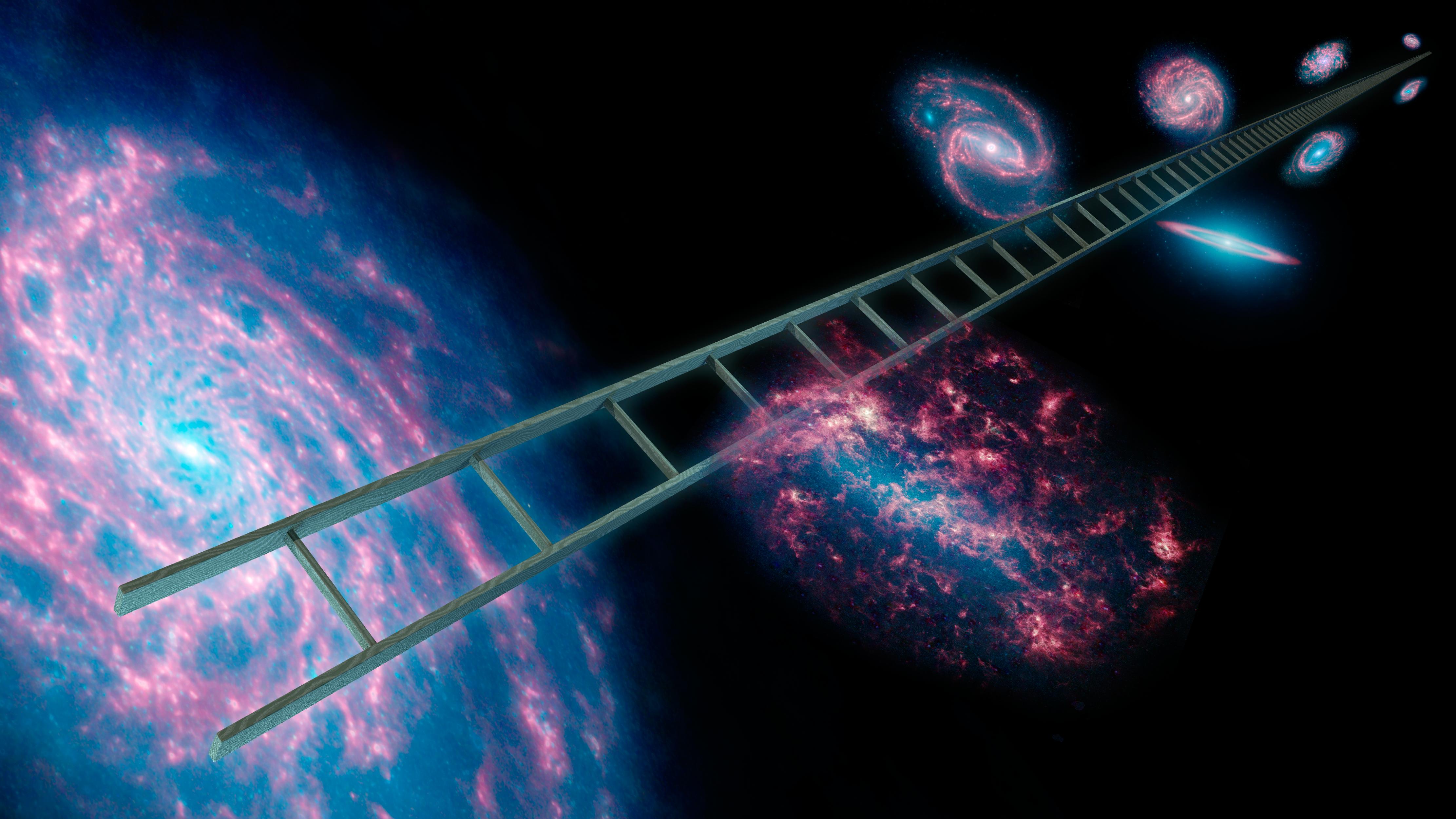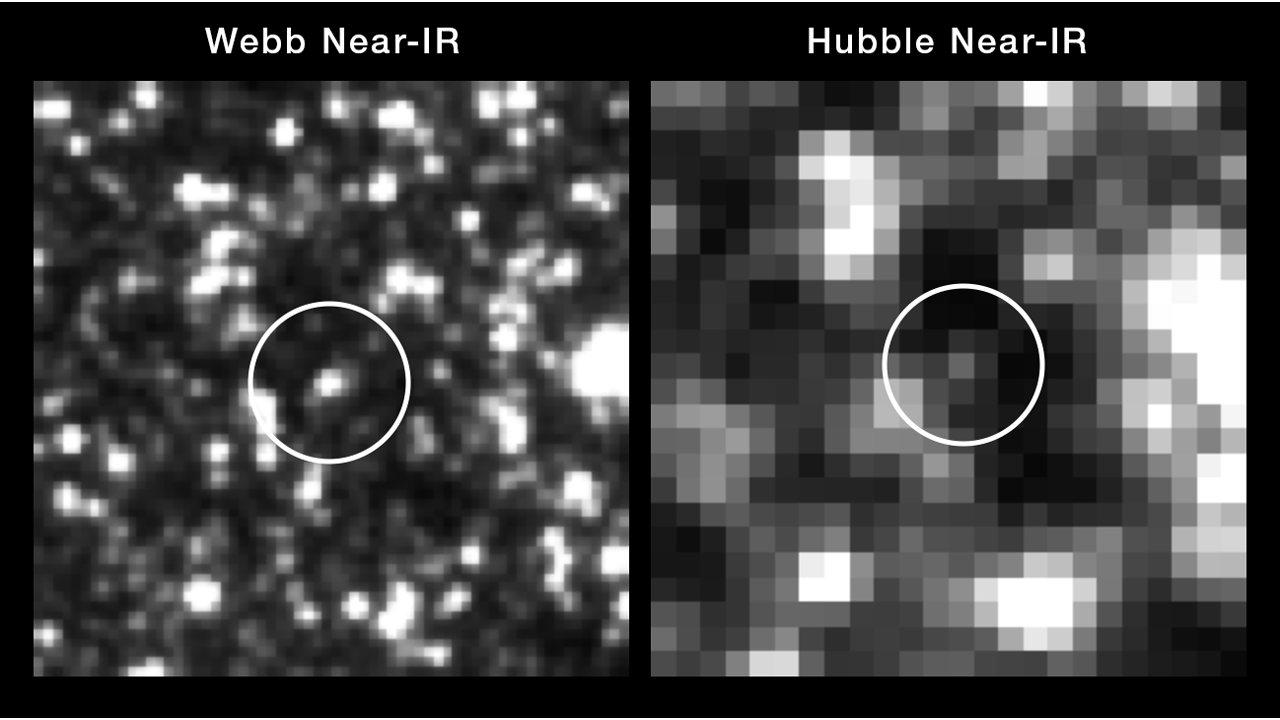James Webb Space Telescope complicates expanding universe paradox by checking Hubble's work
By double-checking the Hubble Space Telescope's results, JWST's observations have ruled out a major source of error in calculating the expansion rate of the universe.

The James Webb Space Telescope (JWST) has double checked the work of its older sibling, the Hubble Space Telescope. Hubble's measurements of the expansion rate of the universe are exemplary, the trailblazing observatory found, further ratcheting up the so-called "Hubble tension."
Putting it simply, measurements of the expansion rate of the universe, defined by a property called the Hubble constant, just don't add up.
Related: Dark energy is forcing the universe to expand. This new observatory may show us how
On one hand, observations of the cosmic microwave background (CMB) radiation, which is like a baby picture of the cosmos from just 379,000 years after the Big Bang, say the universe should be expanding today at a rate of about 67.8 kilometers per second per megaparsec. This means that every volume of space a million parsecs (3.26 million light years) across should be expanding at a rate of 67.8 kilometers (42.1 miles) every second.
An alternative way to measure this expansion is by climbing onto the cosmic distance ladder, where each rung is formed by a different astrophysical milestone such as Cepheid variable stars and Type Ia supernovas. How bright these objects are can tell us their distances, which we can then compare to their redshift values to determine how much the universe has expanded while their light has been traveling to us. The problem, however, is this method gives us a completely different value of the Hubble constant: Somewhere around 73.2 kilometers (45.5 miles) per second per megaparsec.
The apparent paradox between the two measurements is what cosmologists have started calling the Hubble tension. Nobody knows what is causing it, but some hypotheses call for new physics to explain the apparent contradiction.
One possible explanation is that there is a measurement error on the bottom rung of the cosmic distance ladder, which is home to the Cepheid variables. These are stars with luminosities that predictably fluctuate as the stars pulse in and out. The longer the pulsation period between moments of maximum luminosity, the greater that maximum luminosity is. This period–luminosity relation allows us to accurately calculate their distances to Earth; it's possible to measure the pulsation period to calculate maximum luminosity, then, based on how bright a Cepheid variable appears in the sky to us, we can work out how far away it must be to appear that bright.
Get the Space.com Newsletter
Breaking space news, the latest updates on rocket launches, skywatching events and more!
It's not quite a foolproof method, though.
The Hubble Space Telescope is able to observe Cepheid variables in distant galaxies, but the more distant they are, the harder they become to distinguish among all the other stars that crowd around them. As such, there was a concern that unresolved stars adjacent to Cepheid variables in these faraway galaxies were adding to the Cepheids’ apparent brightness values, creating an unseen and systematic error in the measurements. Interstellar dust can also affect the brightness of Cepheid variables, dimming them from our vantage point on Earth.

But new measurements achieved with the James Webb Space Telescope of five galaxies hosting a combined total of more than a thousand Cepheid variables have ruled this possible error out. The JWST's infrared vision is able to cut through the interstellar dust, while its greater resolution allows it to clearly resolve the Cepheid variables so they stand out from the crowd. From these JWST measurements, astronomers led by Adam Riess of Johns Hopkins University determined that Hubble's original measurements were spot on.
"We've now spanned the whole range of what Hubble observed and we can rule out a measurement error as the cause of the Hubble tension with very high confidence," said Riess in a statement.
The five galaxies observed by the JWST, the most distant of which is NGC 5468 at 130 million light-years from us, have also hosted a combined total of eight Type Ia supernovas over recent decades. These supernovas, which signal the destruction of white dwarfs, have a standardizable luminosity curve, and form the next rung on the cosmic distance ladder above Cepheids. Because the preceding rung is required to calibrate the next rung, the JWST's observations of Cepheid variables therefore makes the distance measurements using Type Ia supernovae — which are bright enough to be seen in much more distant galaxies than Cepheids — more accurate. And they too tell us that there is a contradiction in the different measurements of the Hubble constant.
"With measurement errors negated, what remains is the real and exciting possibility we have misunderstood the universe," said Riess.
The team's results are a long time coming, having previously been available on the pre-print server arxiv and earning chatter late last year. But now that they're published fully, perhaps we can finally close the chapter of blaming Hubble tension on none other than Hubble itself.
The results of Riess' team were published on 6th February in The Astrophysical Journal Letters.
Join our Space Forums to keep talking space on the latest missions, night sky and more! And if you have a news tip, correction or comment, let us know at: community@space.com.

Keith Cooper is a freelance science journalist and editor in the United Kingdom, and has a degree in physics and astrophysics from the University of Manchester. He's the author of "The Contact Paradox: Challenging Our Assumptions in the Search for Extraterrestrial Intelligence" (Bloomsbury Sigma, 2020) and has written articles on astronomy, space, physics and astrobiology for a multitude of magazines and websites.
-
rod My note, using this cosmology calculator, https://lambda.gsfc.nasa.gov/toolbox/calculators.html, H0 = 73 km/s/Mpc and z = 0, age of the Universe 13.083 Gyr. Using 67.4 km/s/Mpc and z = 0, age of the Universe 14.169 Gyr. IMO, the Hubble tension indicates some globular clusters and stars dated can still be older than the age of the Universe in the BB model.Reply
My note, from the 13-page PDF report, "1. Introduction In the past decade, an intriguing and persistent discrepancy referred to as the “Hubble tension”7 has been apparent at high significance (>5σ) between the Hubble constant (H0) directly measured from redshifts and distances, which are independent
of cosmological models, and the same parameter derived from the ΛCDM model calibrated in the early Universe (for a recent review, see Verde et al. 2023). The most significant disparity arises from the strongest constraints. These come from measurements of 42 local Type Ia supernovae (SNe Ia) calibrated by Cepheid variables, yielding H0=73.0 ± 1.0 kms^ −1 Mpc (SH0ES Collaboration; Riess et al. 2022, hereafter R22), compared to the analysis of Planck observations of the cosmic microwave background (Planck Collaboration et al. 2020), predicting H0=67.4 ± 0.5 kms^ −1 Mpc^ −1 in conjunction with ΛCDM." ref - https://iopscience.iop.org/article/10.3847/2041-8213/ad1ddd, 06-Feb-2024. -
Torbjorn Larsson This is progress as the Cepheid distances goes out to z ~.01! Earlier JWST Cepheid measurements did not cover the range up to z ~ 0.007 where the ladder methods that rely on Cepheid calibrations start to suggest new physics QUKUT6JGuvwView: https://www.youtube.com/watch?v=QUKUT6JGuvw&ab_channel=IAA%CE%94%CE%95%CE%A4%2FIAASARS-%CE%95%CE%B8%CE%BD%CE%B9%CE%BA%CF%8C%CE%91%CF%83%CF%84%CE%B5%CF%81%CE%BF%CF%83%CE%BA%CE%BF%CF%80%CE%B5%CE%AF%CE%BF%CE%91%CE%B8%CE%B7%CE%BD%CF%8E%CE%BD ]. So now we have a stark disagreement between those near universe cosmology methods that use the tip of the read giant branch calibration and those that use the Cepheid calibration .Reply
The tip of the read giant branch calibration gets values consistent with both most distant universe cosmology measurements and the Cepheid calibration methods. Another recent near universe method that agrees perfectly with LCDM of the distant universe cosmology is the X-ray eROSITA survey (but its weakness is that it is a sole data analysis so far, e.g. weak lensing agrees with the Cepheid calibration and those are repeated analyses).
Meanwhile it has become almost safe to say that the solution to the differing measurement values do not lie in new physics, as various surveys have excluded it from both the near and distant universe. This seems analogous to the early days of measuring light speed in vacuum, where measurements disagreed but the early average was 10 % from the modern figure - but no new physics appeared when the measurements improved.
That is one reason why the Cepheid calibration methods tend to suggest new physics, they are mildly inconsistent with LCDM. Mildly as in I think there is overlap between their age suggestion and its uncertainty range and the star and cluster ages and their uncertainty, there usually is. Their inconsistency lies within their own data and in respect to other metods or calibrations.rod said:IMO, the Hubble tension indicates some globular clusters and stars dated can still be older than the age of the Universe in the BB model.









